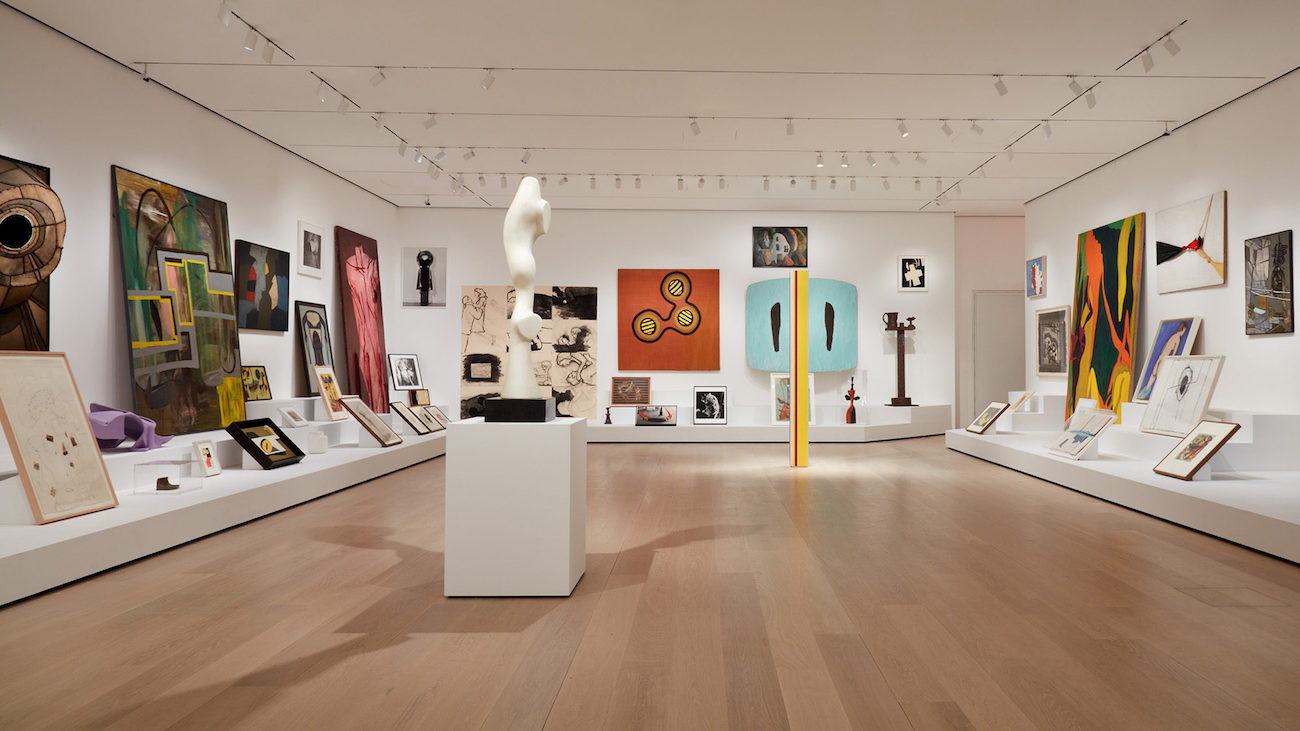[ad_1]
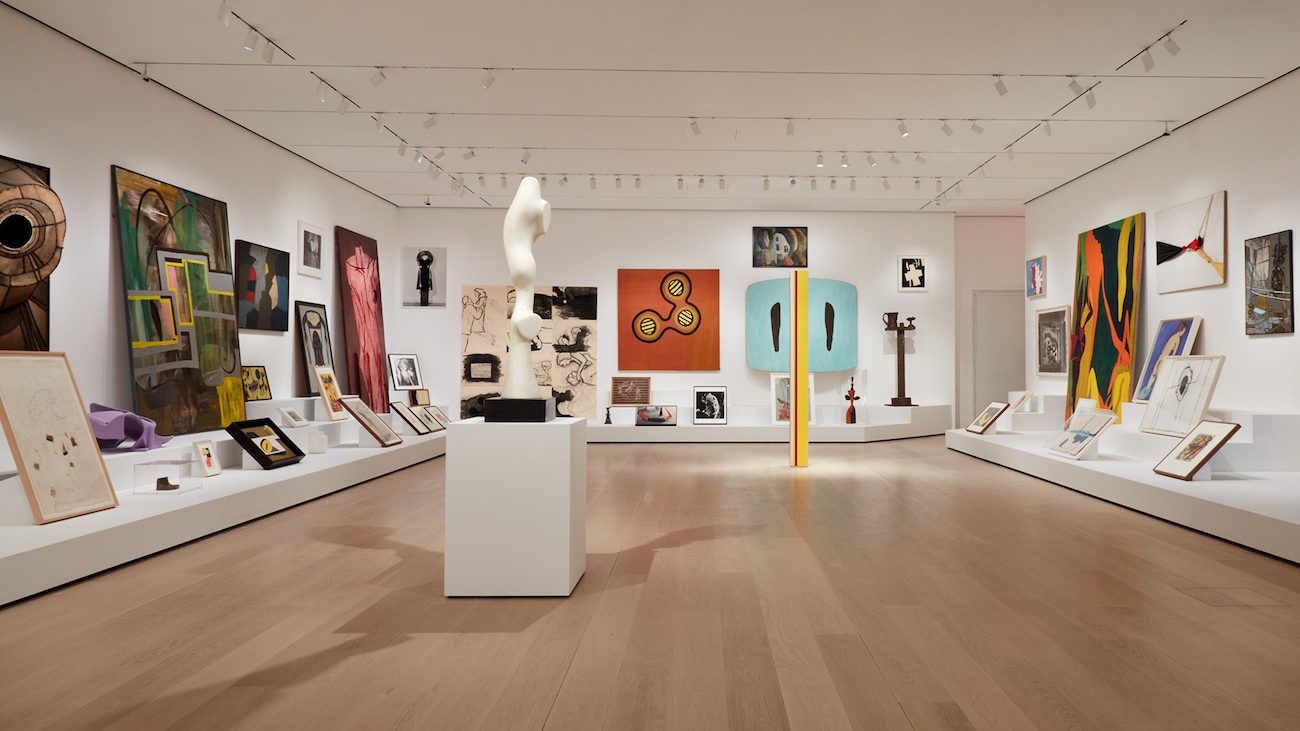
Installation view of “Artist’s Choice: Amy Sillman—The Shape of Shape” at MoMA.
HEIDI BOHNENKAMP/©2019 THE MUSEUM OF MODERN ART
During the 1990s, while pursuing my graduate art history degree at New York University, I worked in the Education Department of the Museum of Modern Art, where I led gallery tours of the museum’s permanent collection for the general public and occasionally VIPs. At that time, the permanent exhibition galleries, representing art produced from 1880 to the mid-1960s, were arranged to tell the “story” of modern art as conceived by founding director Alfred H. Barr, Jr., beginning with Monet and Cézanne, and then leading into Picasso, Futurism, Surrealism, and Jackson Pollock. According to Barr, “modern art” was a synchronic, linear progression of “isms” in which one (heterosexual, white) male “genius” from Europe or the U.S. influenced another who inevitably trumped or subverted his previous master, thereby producing an avant-garde progression. Barr’s story was so ingrained in the institution that it was never questioned as problematic. The fact that very few women, artists of color, and those not from Europe or North America—in other words, all “Other” artists—were not on display was not up for discussion. Indeed, I was dissuaded by my boss from cheekily offering a tour of “women artists in the collection” at a time when there were only eight on view.
By the turn of the 21st century, the relevance of mainstream modernism was being challenged and anti-chronology became all the rage. The Brooklyn Museum, the High Museum of Art, and the Denver Art Museum all rehung their collections according to subject instead of chronology, and a much-anticipated inaugural exhibition at Tate Modern presented the story of modern art through a thematic, genre-based presentation organized into categories (still life, landscape, nude, and history painting). Their display was non-hierarchical, non-centralizing, and inclusive, allowing for jarring juxtapositions like Henri Matisse hanging beside Marlene Dumas.
For its part, in 2000, MoMA organized three exhibitions with the goal of reinventing itself for a newly expanded building and positioning its collection as a sort of laboratory. Sound familiar? The three “MoMA2000” exhibitions were thematic, non-chronological, pluralistic, open-ended, and, at times, playful. As John Elderfield, then-chief curator at large, put it: ”We’re not replacing one orthodoxy with another. We want to show that what was happening until now was an orthodoxy.”
But these postmodern modernist endeavors proved to be failed experiments when the rehangs at Tate and MoMA were almost universally criticized for their anti-chronological approach, which Hal Foster referred to as “a post-historical hodgepodge of disparate works placed together in lookalike groupings.” In response, the Tate re-installed its collection in a series of “hubs” and centralized works around four art-historical moments. MoMA also reverted to the mainstream modernist paradigm: In 2004, a newly expanded museum re-opened with a return to strict art historical “isms,” with the collection galleries installed almost exactly as they had been before “MoMA2000.” Only four percent of the works on display were by women, and even fewer were by non-white artists.
Fast forward to 2019. With great fanfare, MoMA has reopened after yet another major building expansion and has yet again declared intentions to tell a different, more inclusive, and less definitive story. While it purports to be non-chronological, the traditional narrative of modernism is left intact (unlike in 2000), and the ghost of the mainstream modernist timeline remains on the three floors, tracing art history from the 1880s to the present. The museum has done away with “isms” in favor of quirky oftentimes nonsensical themes and dumbed-down gallery headings, such as “Stamp, Scavenge, Crush” and “Inner and Outer Space.”
While it might appear that history is repeating itself, the most exciting aspect of the new MoMA is the rise in the number of women, non-white, and non-Western artists on view. But while the collection reflects greater diversity, it still needs much improvement. Of the 1,443 works on display, only 336 are by women artists—making for 23 percent. (This does not include the Amy Sillman’s “Artist’s Choice” installation, for reasons outlined below.)
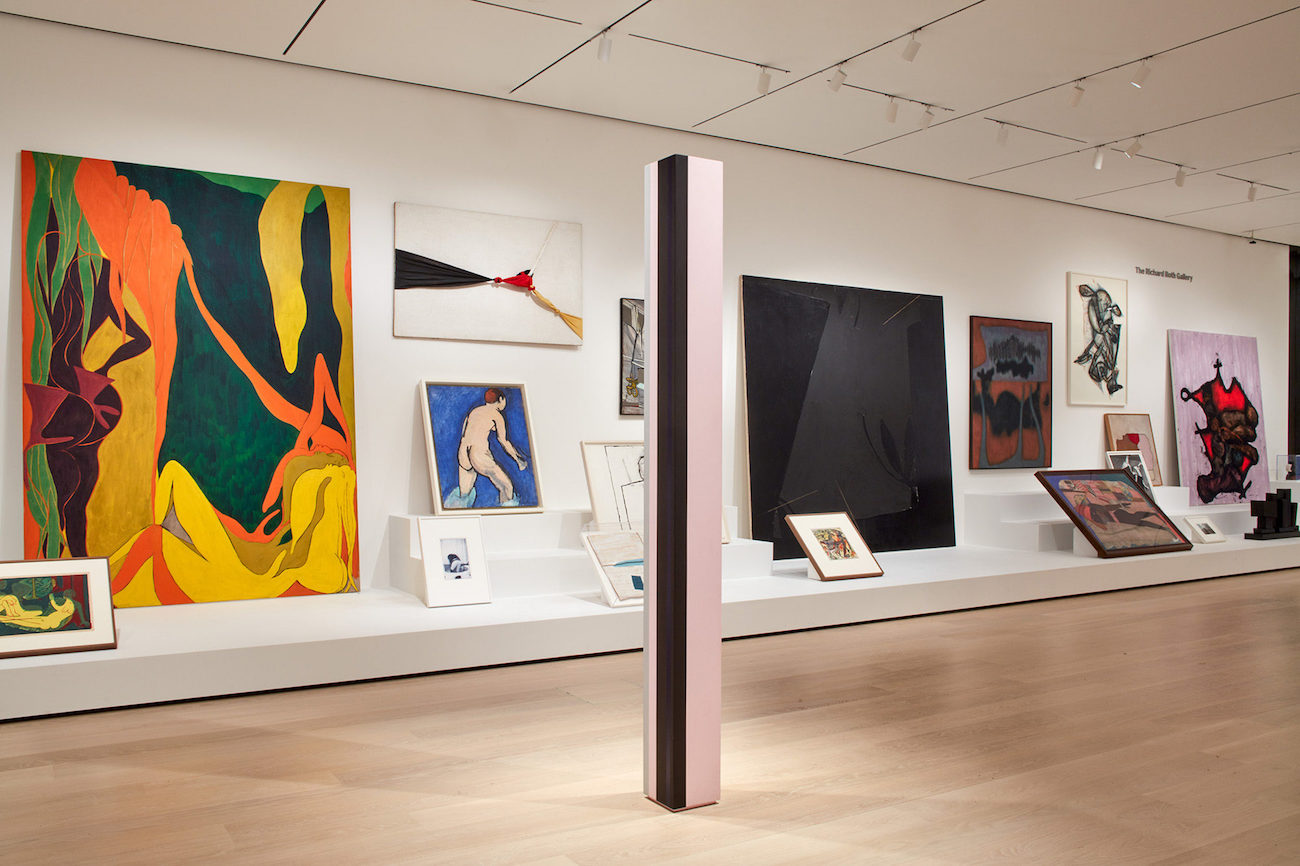
Installation view of “Artist’s Choice: Amy Sillman—The Shape of Shape” at MoMA.
HEIDI BOHNENKAMP/©2019 THE MUSEUM OF MODERN ART
While some critics have found the new collection installation worthy of great praise and full of exciting juxtapositions, I tend to disagree, especially as pertains to the various interventions. For instance, in a room functioning as a virtual shrine to Pablo Picasso, with 13 early paintings and sculptures by the modern “master,” MoMA’s curators have placed a monumental work by African-American artist Faith Ringgold. The painting from 1967, titled American People Series No. 20: Die, depicts a race riot in progress, with bloodied and contorted interracial bodies strewn across the canvas.
I am thrilled that Ringgold is being given long-overdue prominence in MoMA’s permanent collection galleries. She certainly deserves it. However, I am disappointed in her placement. Why is she integrated into a room dedicated to a white male master? MoMA justifies the placement like so: “Ringgold based her composition on Picasso’s Guernica (1937)—the artist’s response to the atrocities of the Spanish Civil War—which she regularly visited when the monumental canvas was on display at The Museum of Modern Art.”
Positioned as she is, Ringgold is presented as a derivative of Picasso, or as a supporting character. The irony is that Picasso himself, in his desire to reinvent painting, borrowed motifs from the tribal art he saw in 1907 at the Musée d’Ethnographie du Tocadéro. His Cubism was derived from African art. Is the placement of the single Ringgold in this room, then, MoMA’s attempt to acknowledge Picasso’s African influences by way of an African-American artist?
The fact that MoMA chose to present such an intervention in light of the never-ending criticism of its own much-maligned 1984 exhibition “‘Primitivism’ in 20th Century Art: Affinity of the Tribal and the Modern” is all the more interesting. That show exhibited tribal objects from Africa, Oceania, and North America without labels or explanatory wall text alongside works by Gauguin, Picasso, and Constantin Brâncuși, in order to show their influence upon modernism as a movement. The exhibition’s curator, William Rubin, expressed publicly that he was not interested in the tribal works in themselves, but only in the way they acted as inspiration for the Western avant-garde. The exhibition met with an outcry of criticism spearheaded by Thomas McEvilley, who argued that the museum was really co-opting non-Western cultures and using them to consolidate Western notions of quality and feelings of superiority.
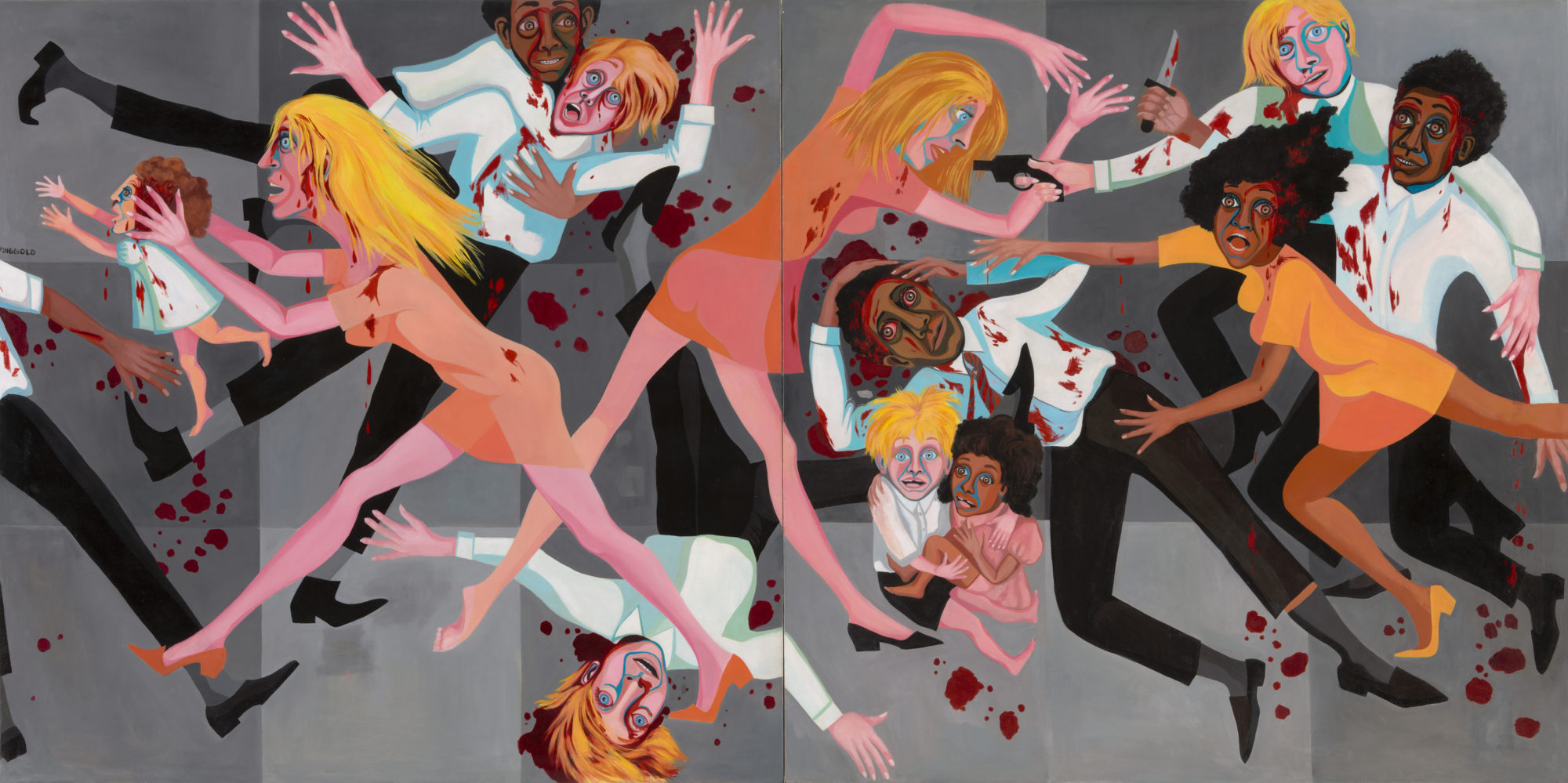
Faith Ringgold, American People Series #20: Die, 1967.
COURTESY THE MUSEUM OF MODERN ART
Regardless of whether you think Picasso stole from African Art, with the Ringgold intervention MoMA appears oblivious to continued controversies that such appropriation stokes. If Ringgold based her composition on Picasso, who had based his composition on African art, is MoMA now attempting to make reparations for him? Does Ringgold need to be linked with Picasso to validate her genius?
Given that Ringgold’s work of the ’60s was not influenced by Picasso alone—she was also fueled by her admiration for the writings of James Baldwin, the paintings of Jacob Lawrence, and the decorative work of the Kuba peoples in Zaire, to name just a few examples—it might have been more interesting to include her work in relation to Lawrence’s Migrant Series, also on view in the museum. Or, more radically, why didn’t MoMA present an entire room dedicated to Ringgold, with multiple paintings and sculptures, and then place a single Picasso work therein?
What Holland Cotter in the New York Times called “a stroke of curatorial genius,” I call tokenism. This was also the case with the placement of a single Alma Thomas painting in an all-Matisse room. Is MoMA trying to make amends for wrongs of the past, which have celebrated an almost exclusive parade of white male superstars—and especially Matisse and Picasso—by showing an African-American woman holding her own as an abstract painter? As Andrew Russeth asked in ARTnews, “Why just one? It reads as tentative. Why not go half-Thomas and half-Matisse, and see what kind of fireworks these two great colorists shoot off?”
Perhaps the best example of problematic curating is the room dedicated to “Florene Stettheimer and Company.” In this small space—let’s call it “The Ladies Room”—one finds 21 works, with 18 by women artists and three by men (two of them by Marcel Duchamp), which is not to say that Stettheimer had only women friends but rather that the curators decided to bunch together a random group of works by old and new artists who happen to be women into one gallery. Stettheimer herself would likely not have approved, as most of the contemporary artists on display (Cosima von Bonin, Sylvie Fleury, Louise Lawler, Rachel Whiteread, Frances Stark, Jutta Koether) have little in common with her other than their female sex. Similarly, the historic works presented—by Sophie Taeuber-Arp, Baroness Elsa von Freytag-Loringhoven, Hannah Hoch, and Sonia Delaunay-Terk—make no sense within this context either. While these latter women may have shared the same historical moment, none of them knew Stettheimer personally. Why were they exhibited here?
The confusion is thrown into higher relief when one considers who actually was in Stettheimer’s artistic circle, many of whom have major works in MoMA’s collection: Elie Nadelman, Albert Gleizes, Alfred Stieglitz, Gaston Lachaise, William Zorach, Edward Steichen, and Kenyon Cox, among others. Why not a room showing works by these artists to contextualize Stettheimer’s genius as a major avant-garde figure of the early 20th century?
If there is one reason to visit the new MoMA, it is to experience New York painter Amy Sillman’s curated exhibition “The Shape of Shape,” the latest iteration of the museum’s “Artist’s Choice” series. The large room presents 71 objects from the collection arranged in super-close proximity and at angles rarely encountered in a museum. Many are by overlooked artists who are no less brilliant than those who have been canonized, while others are unfamiliar works by canonical artists. Like a cabinet of curiosities, the presentation is ahistorical, non-chronological, and organized according to visual or formal affinities—in this case, shapes and shape-makers. As Sillman explains in her wall text, “I wonder if, in fact, shape got left behind when modern art turned to systems, series, grids, and all things calculable in the twentieth century. Was shape too personal, too subjective, to be considered rigorously modern? Or is it just too indefinite, too big, to systematize?”
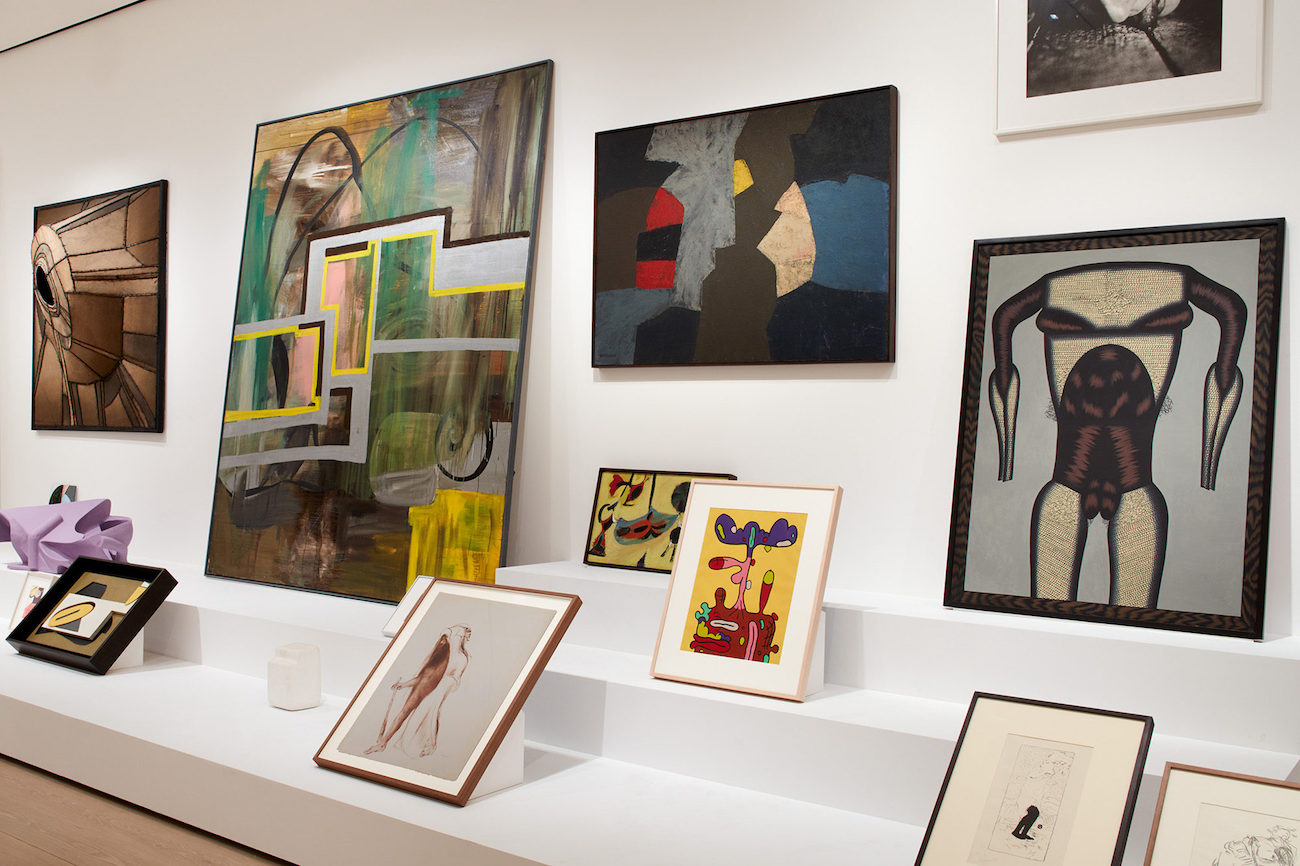
Installation view of “Artist’s Choice: Amy Sillman—The Shape of Shape” at MoMA.
HEIDI BOHNENKAMP/©2019 THE MUSEUM OF MODERN ART
Organized as they are, a sculpture from the 1950s by Romanian-born Cuban artist Sandu Darie interacts visually with a Fernand Léger’s Purist painting The Mirror from 1925 on one side, and on the other by a small 1962 painting Zimbabwean artist Thomas Mukarobgwa. In another dialogue, a small painting by Ulrike Müller from 2017 and a tiny Marcel Duchamp sculpture are juxtaposed with a mammoth, cavernous Lee Bontecou from 1959. In another curious instance, a Forrest Bess painting from 1949 hangs unexpectedly beside a Senga Nengudi photograph of a performance from 1977. Many such intriguing, intercultural, and intergenerational visual exchanges abound. Sillman’s is also the most diverse of all of the new collection displays in terms of gender, with 38 percent of the works produced by women artists.
Sillman has organized the works in a personalized manner, outside the confines of traditional art history. The objects are presented context-free, with no wall labels. One is encouraged to walk through the installation with (or without) a hand-out with full captions. Doing so frees the viewer’s mind and eye to appreciate the multitude of shapes that Sillman has organized for our visual pleasure. As curator Jean Hubert-Martin argued in my book Curatorial Activism: Towards an Ethics of Curating (2018): “You don’t need cultural references to enjoy a work of art.” Our senses can do the work for us. In recognizing that, Sillman’s installation has broken down the once-traditional approach to and viewing of art, transcending the borders of genres, eras, and distinct cultures. In her configuration, time is not linear or long but wide and kaleidoscopic. Hers is an ahistorical presentation, with no hierarchical implications and no consideration of borders, races, genders, or periodic categories.
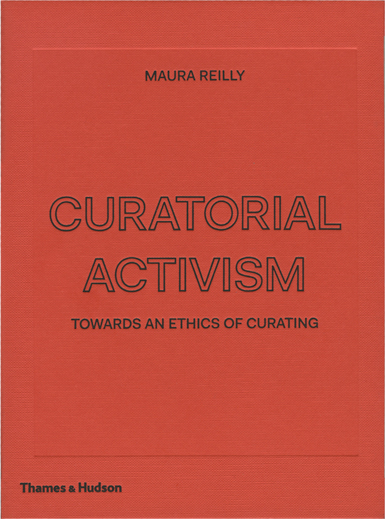 Sound familiar, again? Sillman’s display brings us full-circle to that moment in 2000 when MoMA was first attempting to redefine itself and installed their first collection iteration non-hierarchically and ahistorically as “Modern Starts: People, Places, and Things.” Instead, the 2019 collection display is revisionist in nature. In what seems like an effort to address the sins and errors of the past, MoMA is attempting an integrative approach, inserting artists back into the mainstream canon within which they had either been marginalized or made invisible. MoMA’s principle aim here, it seems, is to revise the canon, to rewrite it—in short, to expand it to include what it had hitherto refused, forgotten, or hidden: women, for instance, and minority cultures. While revisionism is an important curatorial strategy, it also assumes the white, masculinist, Western canon as its “center” and accepts its hierarchy as a natural given.
Sound familiar, again? Sillman’s display brings us full-circle to that moment in 2000 when MoMA was first attempting to redefine itself and installed their first collection iteration non-hierarchically and ahistorically as “Modern Starts: People, Places, and Things.” Instead, the 2019 collection display is revisionist in nature. In what seems like an effort to address the sins and errors of the past, MoMA is attempting an integrative approach, inserting artists back into the mainstream canon within which they had either been marginalized or made invisible. MoMA’s principle aim here, it seems, is to revise the canon, to rewrite it—in short, to expand it to include what it had hitherto refused, forgotten, or hidden: women, for instance, and minority cultures. While revisionism is an important curatorial strategy, it also assumes the white, masculinist, Western canon as its “center” and accepts its hierarchy as a natural given.
The Ringgold intervention is an excellent example. The problem is that with a revisionist strategy there is still a binary opposition in place. In other words, we must be wary of revisionism that becomes a kind of homage. Revising the canon to address the neglect of women and/or minority artists is fundamentally an impossible project because such revision does not grapple with the terms that created that neglect in the first place.
In the end, it would have been more interesting for MoMA to have opted for total transparency, admitting its sins and omissions publicly by presenting what one might call a separatist agenda: an all-woman show across three floors (as the Pompidou Center in Paris did in 2009–11), or an exhibition consisting entirely of non-white artists. MoMA has the collection to implement either of these scenarios and, if critical pieces were missing, it certainly has the money for acquisitions. Even more radically, perhaps, MoMA could have invited Amy Sillman to re-install the entire collection. Any of those scenarios would have made for a far more ingenious new beginning for the museum.
[ad_2]
Source link

